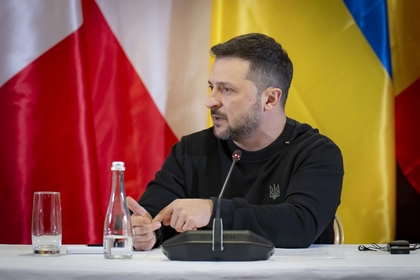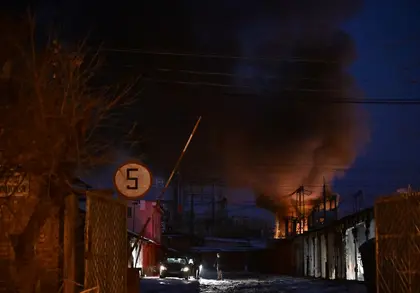What’s the problem?
Russia has for months now been deliberately targeting Ukraine’s energy infrastructure with massive missile and drone attacks, leaving swathes of the country in darkness and authorities scrambling to ensure the population can survive the brutally cold winter season.
JOIN US ON TELEGRAM
Follow our coverage of the war on the @Kyivpost_official.
These attacks target both the plants that generate power and the network which distributes it. Numerous power plants have been damaged in these attacks and ongoing fighting in other areas mean some of Ukraine’s nuclear powerplants, on which the country relies heavily, are often offline.
Compounding the problem, Ukraine’s ability to exploit its own gas and coal resources have been severely curtailed by Russia’s invasion.
In short, Ukraine has a major energy problem.
What’s the solution?
Russia ending its invasion, going back home, and leaving Ukrainians in peace.
OK, that’s probably not going to happen any time soon. Is there another solution?
According to President Zelensky, the acquisition of vast supplies of natural gas for power generation could offset the damage caused by Russia’s strikes against the rest of the grid.
Speaking to the European Council earlier this month, he said: “In order for the next six months to pass without shocks, we need to do something else. In particular, we need support to purchase the volume of gas that is used to compensate for the damage caused by Russian strikes on other types of generation. We are talking about 2 billion cubic meters of gas."

Zelensky Criticizes G20’s Weak Position on Russian Invasion
That’s a lot of gas.
It certainly is, which raises the questions: Where do you get it from? How do you get it to Ukraine? And who’s going to pay for it?
What are the options?
Kyiv Post asked Matthew Bryza, a former U.S. ambassador to Azerbaijan and former White House and Senior State Department Official, for his take.
“I’m working on a project with suppliers in Azerbaijan and the United States that supply liquefied natural gas (LNG) to Europe via Bulgaria,” he said.
The challenge, he said, is to bring gas to Bulgaria through ports equipped with facilities that can turn liquid back into gas
LNG is an approach that uses supercooling to convert natural gas into liquid for further transportation by ship. Whereas ordinary natural gas can only be transported by pipeline.
LNG is much more expensive than pipeline gas supply. However, this technology provides the option of other sources of natural gas, in addition to the main supplier.
Bryza also highlighted another possible route via Poland, which now has the ability to import LNG from the U.S. or Qatar. This could then be sent to Ukraine by reversing the flow of a pipeline that previously ran east to west through Slovakia.
Sounds great, let’s do it.
There’s a catch – because of surging global prices for energy, this would not be cheap.
“Ukraine will want a lower price and I think there are many governments and governmental institutions willing to help Ukraine,” Bryza said.
“For example, the U.S. government's Development Finance Corporation, and Export-Import Bank – they will both provide financing to make it more affordable essentially for Ukraine to acquire that gas. And the same is true for the European Bank for Reconstruction and Development.”
This is all great in theory, but is anything actually being done?
Yes. Earlier this month Turkish President Recep Tayyip Erdogan backed the creation of a new natural gas pipeline that could ease Europe's dependence on Russia by linking up with energy-rich Turkmenistan.
Erdogan has long dreamt of using Turkey's location on the edges of the Middle East and Europe to turn it into one of the world's main hubs for the energy trade and he is now able to take advantage of the fact that Central Asian countries have been reassessing their once-close relations with Moscow since Russia's war on Ukraine.
This new pipeline could provide one of the transit routes that Bryza discussed. “It could deliver gas from Turkmenistan along the path under the Caspian Sea to Azerbaijan,” he said. “Then to Georgia and to Turkey, and then from Turkey that gas can continue into Bulgaria and multiple directions including to Ukraine.”
Bryza also noted that the race for EU countries to release themselves from Moscow’s gas stranglehold will ultimately benefit Ukraine.
For example, Germany used to have only Gazprom. That is why, according to Matthew Bryza, Germany is building several new facilities that can regasify LNG.
"Germany now is rapidly building five of those regasification facilities that will turn liquefied natural gas back into natural gas. In Germany, the natural gas network is connected to the rest of Europe, which is eventually connected to Ukraine. Greece is working on two new regasification terminals. Moreover, Turkey has four factories that turn liquefied natural gas back into normal gas.”
Bryz added that Turkey also has gas flowing in from Iran and Azerbaijan, and shortly from Turkmenistan via Azerbaijan. “If the proper contracts can be negotiated, all that gas can make its way to Ukraine,” he said.
He also noted that in recent years, the EU has invested in new connections of gas pipeline systems in different countries. That way gas can be moved around Europe to meet demand.
"So, for the last decade the European Union has been trying to build interconnections and create more of the liquefied natural gas market,” he said. “This can all benefit Ukraine."
You can also highlight the text and press Ctrl + Enter






